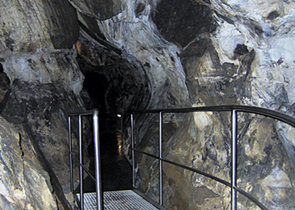Nature Conservation 4/2009 — 31. 8. 2009 — On Nature in the Czech Republic — Print article in pdf
The Na Špičáku Cave

The Na Špičáku Cave is one of the most famous underground karst phenomena of the Jeseníky Karst and one of its two show caves.
It passes through Velký Špičák Hill (518 m a.s.l.), which is a top of the volcanic cone, protruding from continental glacier sediments south of the village of Supíkovice (District of Jeseník, northern Moravia). The cave is formed by massive light-grey, tectonically less damaged compact marbles that are 350–380 million years old. A mostly horizontal labyrinth of passages, fissures and domes was formed by surface water flows in crystalline limestones – marbles. Nevertheless, their heart shaped forms were modulate by underground lakes established by melting of the continental glaciers which had reach what is now the Czech Republic particularly during the last but one Ice Age. The date of the caves’s discovery has not been known, but the first written reference to the cave dates back to 1430. A lot of unique historic inscriptions on walls confirm a frequent presence of humans there. The cave is among the oldest caves in Central Europe, having been documented by with written evidences. Because The Na Špičáku Cave became officially accessible to the public in 1885, it also is one of the first show caves in the country. The cave has no stalactite ornaments, because they were heavily damaged by visitors during centuries when the underground had been freely accessible. Moreover, unconsolidated sinter occurs there, covering ceilings and walls and forming cauliflower – like aggregates. Since 2003, a long--term archaeological research of epigraphic monuments has been carried out there. The cave is a part of a Specially Protected Area, namely the Na Špičáku National Nature Reserve.
Název připojené galerie
Quisque egestas velit non nulla fermentum, aliquet pharetra nunc malesuada. Nullam molestie vel diam non tincidunt. Sed pulvinar lacinia nunc et consectetur. Duis varius leo ac ex scelerisque, ullamcorper eleifend massa consectetur. Nullam in metus ac arcu pellentesque venenatis ac id lorem. Nulla nec ipsum sed enim sodales blandit a sit amet ex.








